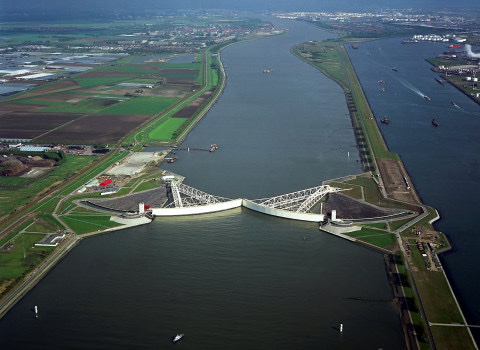Testing the Operating Software for the Maeslant Storm Barrier
Customer
The Maeslant storm barrier, part of the Delta Works in the Netherlands, managed by the Dutch authorities. It is the world’s largest robot and can shut down the “Nieuwe Waterweg” in case of a flood threat.
Challenge
The Maeslant storm barrier is a unique structure with no standard for building and testing its operating software. The failure of this barrier could result in incalculable damage, necessitating extremely high-quality requirements for the development of new operating software. The challenge was to create a robust testing framework that ensures the reliability and effectiveness of the barrier’s software under all conceivable conditions.
Technology
To meet the high-quality requirements, a structured testing approach was adopted using TMap (Test Management Approach) combined with a DTAP (Development, Testing, Acceptance, Production) strategy. The testing was driven by risk assessment and client requirements, with a focus on SCRUM methodology for introducing an agile test approach.
Solution
Our test specialist played a pivotal role in ensuring the quality of the new operating software through a comprehensive and structured testing process:
- Structured Test Approach: Utilizing TMap combined with a DTAP strategy, the tests were defined based on risk and client requirements. The higher the risk, the more intensive the testing.
- SCRUM Methodology: Introducing the SCRUM method to the industrial automation sector brought a new approach and way of testing. This facilitated better planning, execution, and iteration of test activities.
- Collaboration: Continuous consultations with all stakeholders were crucial to achieving the desired quality. Cooperation ensured that all parties were aligned with the testing objectives and methods.
- End-User Testing: End users (blocking administrators) conducted tests under the direction of the test specialist. Testing was not only performed on the end product but also during the realization of the A-environment, where all external influences were simulated to reflect real-world conditions.
- Comprehensive Scenario Testing: The barrier was tested against all conceivable situations to ensure its reliability. This included assessing the working methods of unit and system testers and making necessary adjustments to the test strategy.
Result
The structured and collaborative testing approach led to significant improvements in the quality and reliability of the Maeslant storm barrier’s operating software:
-
- High-Quality Software: The risk-based testing approach ensured that the software met the highest quality standards, capable of handling extreme conditions and scenarios.
- Effective Collaboration: Continuous cooperation and consultations among all stakeholders resulted in a well-coordinated and efficient testing process.
- Innovative Testing Methods: The introduction of SCRUM methodology in the industrial automation sector set a new standard for agile testing practices.
- Realistic Testing Environment: Testing in the A-environment with simulated real-world conditions ensured the software’s robustness and readiness for deployment.
Conslusion
The collaboration with the Dutch authorities on the Maeslant storm barrier project highlights the effectiveness of a structured, risk-based testing approach combined with agile methodologies. By introducing innovative testing methods and fostering strong collaboration, our test specialist ensured the development of high-quality, reliable operating software for one of the world’s most critical flood protection systems.





